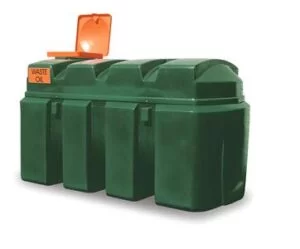There are many reasons as to why you should get a new oil tank. A new tank means that it is less likely to leak than an old one. What is more, you might be looking to increase the capacity of your oil tank.
The installation of a new oil tank needs to meet a number of regulations.
How often should I change my oil tank?
If you always maintain your oil tank on a regular basis, you wouldn’t need to worry about it for at least 10 years. In fact a well maintained oil tank can last well over 15 years.
Read about: Is a heat pump suitable for my property?

What are the signs of an old oil tank?
When you have your oil boiler serviced or checked by a heating engineer, make sure that they take a look at your oil tank during the service. A heating engineer can tell you whether you need an oil tank replacement or not.
It is recommended that you keep an eye on your oil tank from time to time to check for any damages. Here’s a list of the things you need to watch for in an oil tank:
- Oil leaks
- Sign of corrosion for metal tanks
- Damages of any type
- Condensation
- Plastic swelling
Oil tank fitting
Read about: Boiler Repair in UK
You might have come across the term ‘bunded’ a lot while looking for an oil tank. Well, a bunded oil tank simply indicates that there is a tank around the storage tank itself. This extra layer of tank is like a protection for the original tank that contains the oil.
An oil tank that is fitted without bunding has to meet various regulations. In Wales, oil tanks must have bunding.
Read about: Electric Boilers v Gas Boilers
Types of bunding
Integrally bunded
For added protection, your oil tank will be within another layer of tank. These are considered the best type available.
Double bunded (double skinned)
With this type there are two layers in order to protect you against leaks. This is the most common type used for underground installations.
Single skin
A single skin oil tank cannot be more than 2,500 litres in capacity and must meet plenty of regulations. Some of these include the following:
- You tank must be further than 10m from water
- Not installed above hard ground
- Away from drains
Read about: Top UK Heat Only Boilers

Where should I put an oil tank?
There are three places you can use to place your oil tank in. It can be installed outside, inside or underground.
Outside (above ground)
This is the most common place for most oil tanks. However, there are certain regulations the oil tank must meet before being installed outside. Your tank must be:
- 1.8 metres from windows, doors, garden sheds and the flue pipe of the oil boiler
- 760mm from a non-fire-rated boundary
- 50 metres away from a well, spring or a borehole
- 10 metres away from a water source such as a stream, a river or a pond
- Must not be fitted in an area that might face flooding or near a manhole
Read more: Affordable Boiler Prices
What is more, an oil tank needs to be installed on top of a base of concrete or paving slabs. There are certain criteria for the base to meet as well:
The base must cover an area of 300mm around the outside of the tank.
It must be a fireproof material
Concrete must be 100mm think and paving slabs 50mm thick (minimum)
Above-ground indoor
An oil tank can be installed inside, normally in a garage or outhouse. But the room must be dedicated to the oil tank and contain nothing else.
For internal installation to be possible, the tank must have a capacity less than 3,500 metres and be accessible from all sides. There must also be at least 1.8 metres between the tank and any doors or windows. And even though it’s inside, the environment still needs to be considered in case there’s a leak.
Inside (above ground)
An oil tank can be placed inside, usually in a garage or an outhouse. But in this case the room must be dedicated just for the oil tank and nothing else.
An oil tank that is being placed inside must have a capacity of less than 3,500 metres and should be in a position that can be accessed from all sides. A space of 1.8 metres should also be left between the tank and any windows or doors. Concerns for leaks should also be taken into account even though the tank is indoors.
Underground
If you want to save up space in your garden and to keep your oil tank out of sight, then installing your tank underground is the answer. But keep in mind that the cost of such an operation can be high considering how challenging it is. What is more, it can take up a fair amount of time and effort.
An underground oil tank must be double-bunded considering the significant environmental issues it can cause in case of leaking.

What oil tank size is the best for my home?
Oil tanks come in various sizes. You can get a tank from around 500 litres to 10,000 litres. The best size for your home will depend on different factors:
- How much you use your boiler
- How much space you have for the tank
Generally speaking, a 500 litres oil tank is normally suitable. However, if you have available space, it wouldn’t hurt if you want to get a bigger tank. An adventure of a bigger tank is that they do not need to be fuelled often and thus can save you money.
How much do new oil tanks cost?
New oil tanks can cost between £1,100 to £2,000. As for the installation cost then it can reach around £1,000.
There are some additional costs to put in mind. Draining oil which is left in your old tank might cost around £300 to £350. This would usually be done by your supplier. Another £500 might be added if a new trench is needed for the oil pipe.
Things to be aware of as an oil tank owner.
You will be responsible for any oil leaks that might take place. Oil leaks can harm the environment. You might be required to pay to clean the oil spill or any damages.
FAQs
Do I need planning permissions for an oil tank installation?
You will need planning permissions for an oil tank installation if you live in a listed property. Otherwise, it will depend on where you are going to place your tank and how high it is. To be completely sure, it is better to check with your local council.
FAQs about Oil Tank Replacement
Do I need planning permissions for an oil tank installation?
You will need planning permissions for an oil tank installation if you live in a listed property. Otherwise, it will depend on where you are going to place your tank and how high it is. To be completely sure, it is better to check with your local council.
What are oil tanks used for?
Oil tanks are used for storing oil that is used to power your heating system if you have an oil boiler.
What type of oil tank is the best?
The best oil tank on the market is the integrally bunded oil tank.





